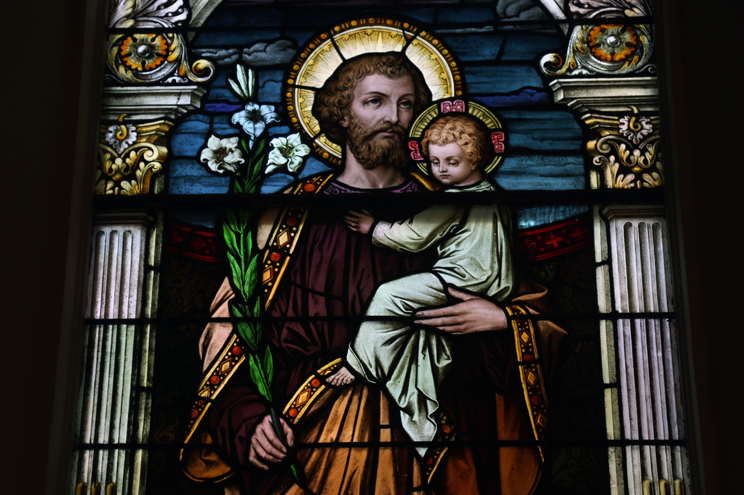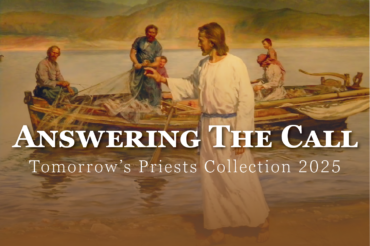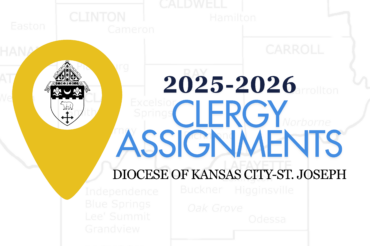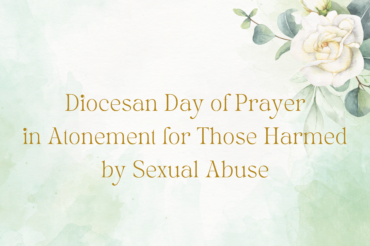Bishop Johnston: Safe Haven Sunday
March 3, 2019
Greetings in Christ!
Today’s Gospel reading begins with Jesus telling his disciples a parable. He begins with two questions, “Can a blind person guide a blind person? Will not both fall into a pit?”
This weekend we are celebrating Safe Haven Sunday throughout our diocese. I am addressing all the faithful of our diocese through this letter to raise awareness so that we can lead our young people away from a modern-day pit that so many are falling into today. This is my invitation to you: consider the serious responsibility that we all share to protect our children from harm. We live in a culture that contains many hazards to both the moral and spiritual health of our children. In recent years much has been done to make our schools and parishes safer for the children of our diocese.
Many of you are aware of our mandated safe-environment training, background checks, and ethical standards that have been in place and have made a profound impact on the culture in our diocese. And, this past week in Rome, a summit called by Pope Francis is sought to address greater change in the Church universal for safety, accountability, and healing.
While our schools have done much, many of our homes still have more to do. Technology, entertainment, and the intemet have given us many good things. But, they also have a dark side. For the sake of this message being delivered at Holy Mass I will use the term “bad pictures.” I think we all know just what I’m talking about and I think this is a very helpful term for parents to use to explain what this evil is, especially prior to first exposure. Perhaps you are already aware of the gravity of our current situation? Just in case, here are just a few alarming statistics.
This problem is now among the leading causes of divorce. In a 2018 report, 56 percent of U.S. divorces involved one party having “an obsessive interest in [these bad picture and video] websites.”
The average age of first exposure to these bad pictures has dropped dramatically in the past decade. A study from last year revealed that 51 percent of male students and 32 percent of female students first viewed bad pictures or videos before age 13.
Increasingly, viewing bad videos is leading children to copy that behavior with other children. According to Heidi Olsen, an RN who practices nursing at Children’s Mercy Hospital in Kansas City, the biggest age range of people committing indecent assaults against children are other children ages 11-15 years old. In a July 2018 article in which Heidi shared this new development, she comments on the cause of this phenomenon, “[Bad videos] are often a main factor, and sometimes the only factor, that influenced a child to act out in [this] harmful way,” she wrote.
I realize that it is agonizing for most parents to even think of talking to young children about internet safety.
Your children are growing up in a different world than you did-a world where a predatory industry is seeking to corrupt your children using tactics designed to hotwire their brains and cause addiction.
As parents this is your territory. You are the first educator, first responder, and first counselor for your children, especially in the area of chastity. Once children have Mobile devices with access to bad content it’s not just looking at bad pictures that you’ll need to prepare them to deal with. There are the social apps that can lead to real life harm, photo sharing that can lead children to engage in risky and degrading behavior, and more apps and settings than most parents will ever be able to figure out. It’s a lot for a parent to handle.
However, when parents face this danger head-on by talking openly and with mercy and truth, kids don’t have to face it alone.
As your bishop, may I suggest a few things that parents can do.
- Develop trusting relationships with your kids. If you’re not talking with your children about this, who will help them navigate their technology use and media consumption?
- Nurture a life of virtue and prayer; pray as a family and encourage them to frequent the sacrament of confession. We have provided parishes with prayer cards and I encourage you to take them home.
- Consider using monitoring and blocking software and pay close attention to what happens at school, friends’ homes, anywhere that might have screens that you can’t monitor.
- Learn the facts about the dangers. Make a plan, pray, and make your plan a reality for the sake of your children and their future. We have partnered with Covenant Eyes to provide a free, easy-to-use 7- day educational program and a free month of access to their monitoring and blocking software. You will find the sign-up information on the prayer cards and, if your parish has provided them, a booklet called “Equipped: Smart Catholic Parenting.” If you have a smart phone, please take a moment to sign-up right now. It’s ok to take out your phone in church for this important purpose. Simply text the word SECURE to 66866.
- Finally, here’s something all of us can do, even if we don’t have children living at home. It is connected to one of the Priorities in our diocesan Mutually Shared Vision- “Healing our Family.” We can follow Jesus’ advice from today’s Gospel and “remove the wooden beam from” our own eye. We can resolve to live our own discipleship in such a way that we can boldly speak about this sin with conviction in God’s mercy and truth. We can pray and fast for those we know who are afflicted by this sin. We can draw close to Jesus for our own needs and receive his mercy and healing.
This is a battle we can win. In fact, it is a battle that has already been won by Jesus Christ, Our Savior. This is the Good News proclaimed so boldly by St. Paul in our second reading today- “Thanks be to God who gives us the victory through our Lord Jesus Christ. Therefore, my beloved brothers and sisters, be firm, steadfast, always fully devoted to the work of the Lord, knowing that in the Lord your labor is not in vain.”
Gratefully yours in Christ,
Safe Haven Sunday FAQ’s, Resources & More (Family Life Office)
Protecting Your Family Tips & Tools (Family Life Office)
3 de Marzo 2019
¡Saludos en Cristo!
La lectura del Evangelic de hoy comienza con Jesus contando una parabola a sus discipulos. Comienza condos preguntas: “¿Podrá un ciego guiar a otro ciego? ¿No caerán los dos en el hoyo?”
Este fin de semana estamos celebrando el domingo de Un Refugío a Salvo en nuestra Diócesis. Me dirijo a todos los fieles de nuestra Diócesis por media de esta carta para crear conciencia y asi poder alejar a nuestros jóvenes de un hoyo moderno en el que tantos estan cayendo hoy. Esta es mi invitación para ustedes: consideren seriamente la responsabilidad que todos compartimos para proteger a nuestros niños de cualquier daño. Vivimos en una cultura que tiene muchos peligros tanto para la salud moral como para la espiritual de nuestros hijos. En los últimos anos se ha hecho mucho para que nuestras escuelas y parroquias sean más seguras para los niños de nuestra diócesis.
Muchos de ustedes están al tanto de nuestro entrenamiento de capacitación obligatoria para un ambiente seguro, verificación de antecedentes, y estándares éticos que se han implementado y han tenido un profunda impacto en la cultura de nuestra diócesis. La semana pasada en Roma, se llevó a cabo una cumbre convocada por el Papa Francisco para buscar un cambia mayor en la Iglesia universal para la seguridad, la responsabilidad, y sanación.
Si bien nuestras escuelas han hecho bastante; muchos de nuestros hogares aun tienen más que hacer. La tecnología, el entretenimiento, y la internet nos han dado muchas cosas buenas. Pero, también tienen un lado oscuro. Porque este mensaje les llega durante la Santa Misa, usaré el término “fotos malas”. Creo que todos sabemos de lo que estoy hablando, y creo que éste es un termino muy útil para que los padres lo usen para explicar lo que este males, especialmente antes de ser expuesto por primera vez. ¿Quizás ya están conscientes de la gravedad de nuestra situación actual? Por si acaso no, aquí hay algunas estadísticas alannantes.
Este problema está ahara entre las causas principales de divorcio. En un reporte del 2018, el 56 por ciento de los divorcios de EE. UU, involucraban a una persona con “un interás obsesivo en los sitios web [de estas fotos y videos malos]”.
La edad promedio de la primera exposicián a estas malas imágenes se ha reducido drásticamente en la última década. Un estudio del año pasado reveló que el 51 por ciento de los estudiantes varones y el 32 por ciento de las hembras estudiantes vieron por primera vez fotos o videos malos antes de los 13 años.
Cada vez más, ver videos malos hace que los niños imiten ese compmtamiento con otros niños. De acuerdo con Heidi Olsen, una enferrnera que trabaja en Children’s Mercy Hospital en Kansas City, dice que la mayoráa de las personas que cometen agresiones indecentes contra niños son otros niños de 11 a 15 anos de edad. En un articulo de julio del 2018 en el que Heidi compartió este nuevo desarrollo, comenta sabre la causa de este fenómeno y escribió: “[Los videos malos] a menudo son un factor principal, yen ocasiones el único factor, que influenció a un niños a actuar en [esta] forma dañina.”
Me doy cuenta de que es agonizante para la mayoría de los padres el pensar en hablar con niños pequenos sabre la seguridad en Internet.
Sus hijos están creciendo en un mundo diferente al que ustedes crecieron-un mundo donde una industria depredadora está tratando de corromper a sus hijos utilizando tácticas diseñadas para conectar sus cerebros y causar adicción.
Como padres este es su territorio. Ustedes son los primeros educadores, los primeros en responder, y los primeros consejeros de sus hijos, especialmente en el area de la castidad. Al tener los niños dispositivos Móviles con acceso a contenido malo, no es solo el ver imagenes malas, sino prepararlos para poder enfrentar la situación. Existen aplicaciones sociales que pueden provocar daños en la vida real, compartir fotos que pueden llevar a los niños a involucrarse en comportamientos riesgosos y degradantes, y más aplicaciones y configuraciones de las que la mayoría de los padres nunca podrán figurar. Esto es mucho para los padres.
Sin embargo, cuando los padres enfrentan este peligro hablando abiertamente y con misericordia y verdad, los niños no tienen que enfrentarlo solos.
Como su obispo, puedo sugerir algunas cosas que los padres pueden hacer.
- Desarrollen relaciones de confianza con sus hijos. Si no está hablando con sus hijos sobre esto, ¿quien los ayudará a navegar el uso y el consumo de los medias tecnológicos?
- Cultiven una vida de virtud y oración; recen en familia e invitalos a frecuentar el sacramento de la confesión. Hemos proveido tarjetas de oración a las parroquias y les invito a que las lleven a casa.
- Consideren usar tecnología de monitoreo y bloqueo y presten mucha atención a lo que sucede en la escuela, en las casas de los amigos, en cualquier Iugar que pueda tener pantallas que no pueda monitorear.
- Conozcan los hechos sobre los peligros. Hagan un plan, hagan oración, y hagan que su plan sea una realidad por el bienestar de sus hijos y su futuro. Nos hemos asociado con Covenant Eyes para proporcionar un programa educativo gratuito y fácil de usar de 7 días, y un mes gratis de acceso a su tecnología de monitoreo y bloqueo. Encontrarán la infmmación de registro en las tarjetas de oración y, si su parroquia les ha proporcionado un folleto titulado “Equipped: Smart Catholic Parenting”. Si tiene un teléfono inteligente, tómese un momenta para inscribirse ahora mismo. Esta bien sacar su teléfono en la iglesia para este propósito. Simplemente envíe la palabra SEGURO al 66866. á é ñ ó í ú
- Finalmente, esto es algo que todos podemos hacer, incluso sino tenemos hijos viviendo en casa. Está relacionado con una de las prioridades de nuestra Visión Diocesana Mutuamente Compartida: “Sanación Familiar”. Podemos seguir los consejos de Jesús en Evangelio de hoy y “saca primero Ia viga de ” tu ojo propio. Podemos decidir vivir nuestro propio discipulado de tal manera que podamos hablar audazmente sobre este pecado con convicción en la misericordia y la verdad de Dios. Podemos orar y ayunar por aquellos que sabemos están sufriendo por este pecado. Podemos acercarnos a Jesús para nuestras propias necesidades y recibir su misericordia y sanación.
Esta es una batalla que podemos ganar. De hecho, es una batalla que ya ha sido ganada por Jesucristo, Nuestro Salvador. Esta es la Buena Nueva proclamada tan audazmente por San Pablo en nuestra segunda lectura de hoy: “Pero ¡gracias sean dadas a Dios, que nos da la victoria por nuestro Señor Jesucristo! Así pues, hermanos míos amados, manteneos jirmes, inconmovibles, progresando siempre en la obra del Señor, conscientes de que vuestro trabajo no es vano el Señor. “
Con gratitud en Cristo,
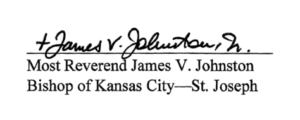
Reverendisimo James V. Johnston, Jr.
Obispo de Kansas City-St. Joseph
Safe Haven Sunday FAQ’s, Resources & More (Family Life Office)
Protecting Your Family Tips & Tools (Family Life Office)

